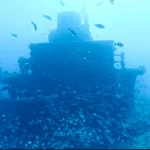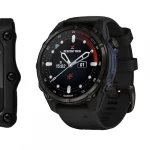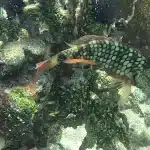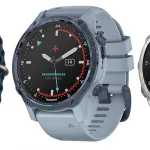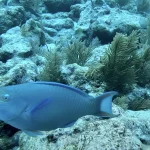Table of Contents
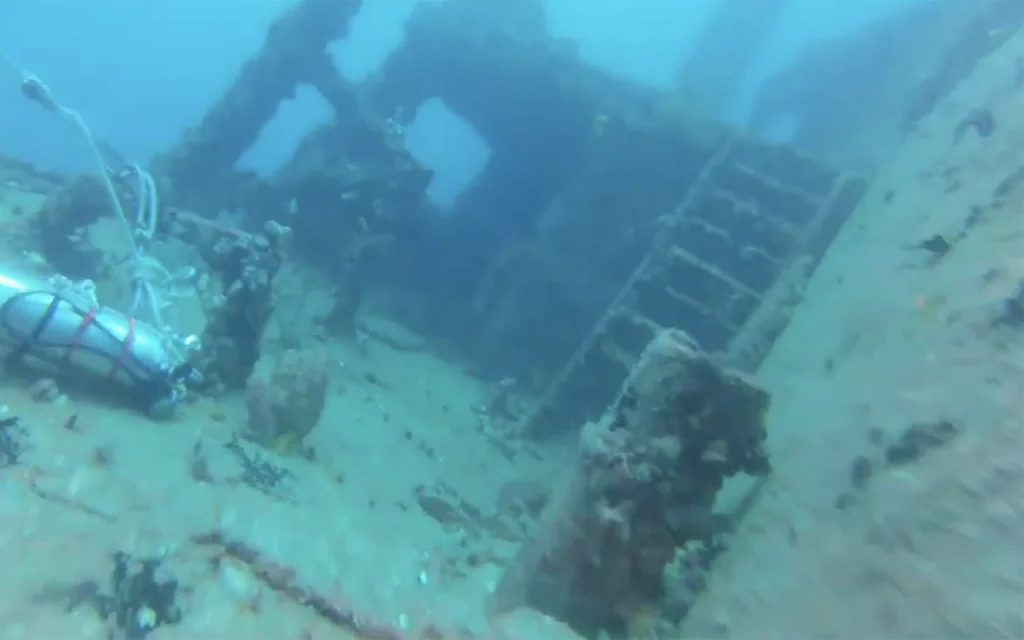
Overall, divers seem to regard the Rodeo 25 as an interesting and rewarding dive site, offering a mix of wreck exploration, marine life observation, and photographic opportunities.
Article at a Glance
- Shipwreck Overview: The Rodeo 25 is a 215-foot Dutch freighter that was intentionally sunk off the coast of Pompano Beach, Florida, on May 12, 1990, to serve as an artificial reef.
- Diving Depth: The wreck is situated at depths ranging from approximately 100 to 125 feet, making it suitable for advanced divers seeking deeper wreck exploration.
- Unique Features: Notable for its twin masts that rise 68 feet above the wheelhouse, the wreck provides excellent opportunities for underwater photography, particularly silhouette shots against the masts.
- Marine Ecosystem: The Rodeo 25 supports a vibrant marine ecosystem, attracting large schools of fish, including jacks and barracuda, and is adorned with colorful orange cup coral.
- Historical Context: The sinking of the Rodeo 25 was a significant event, celebrated by nearly 100,000 spectators, marking the 25th anniversary of the Pompano Beach Fishing Rodeo.
- Safety Considerations: Divers are required to have advanced certifications and must adhere to safety measures, including dive briefings, buddy systems, and emergency preparedness protocols.
- Diving Accessibility: Several dive shops in Pompano Beach, such as Force-E Scuba Centers and South Florida Diving Headquarters, offer trips to the Rodeo 25, making it a popular destination for divers in the area.
Shipwreck Location Coordinates and Depth
Depth
The wreck sits at various depths:
- Top of the superstructure: approximately 65 feet
- Main deck: about 100 feet
- Maximum depth to the seafloor: 125 feet
Location Coordinates
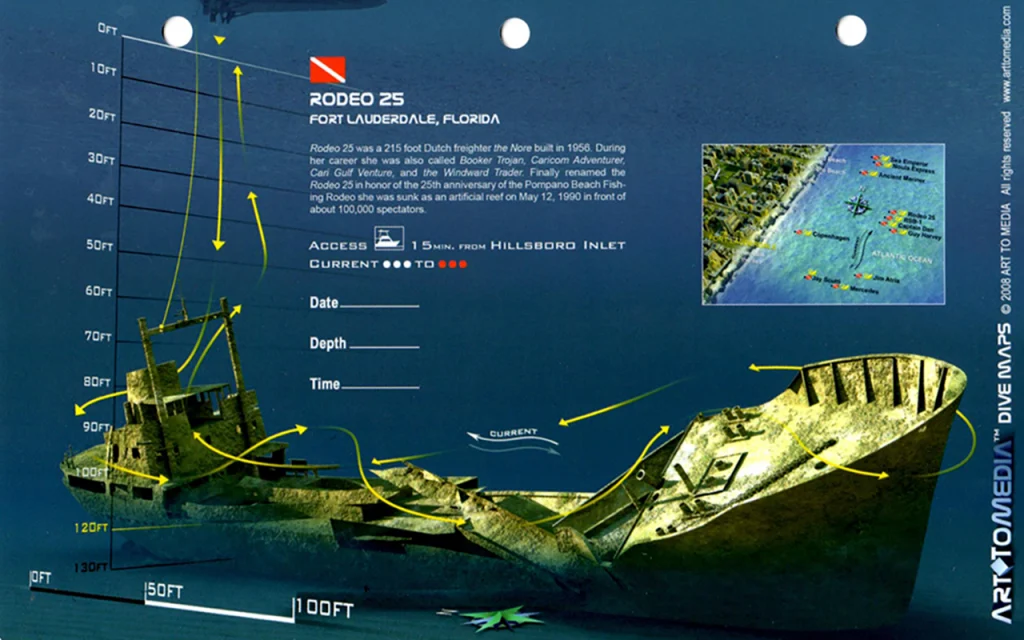
What Do Scuba Divers Say About This Ship
- Popular dive site: The Rodeo 25 is described as an “awesome” diving location off Pompano Beach, Florida.
- Depth: The wreck sits upright at a depth of about 125 feet (38 meters) to the seafloor. The deck is approximately 110 feet (33.5 meters) deep.
- Conditions: On the day of this particular dive, the current was reported to be “hardly noticeable,” which the diver considered a “welcome treat.” However, it’s noted that strong currents are not unusual in this area.
- Water temperature: While not specific to the Rodeo 25, the diver mentions that the East Coast of Florida provides warmer water temperatures (compared to the Gulf side) during winter months, making it an attractive option for divers.
- Accessibility: The wreck is easily accessible from dive operators in Pompano Beach, such as South Florida Dive Headquarters.
- Dive type: It’s considered an advanced wreck dive, suitable for experienced divers or those under direct supervision of an instructor.
- Marine life: While not mentioned in this specific account, other sources indicate that the wreck is known for attracting large schools of fish and predators like jacks, providing an exciting spectacle for divers.
- Photography opportunities: The wreck’s structure, particularly its twin masts rising 68 feet above the wheelhouse, is noted to create excellent opportunities for underwater photography, especially for silhouette shots.
What Kind of Marine Life Can Be Found on The Ship
Common Sightings
- Large schools of fish, often referred to as “bait balls”
- Predatory fish like jacks, which are attracted to the bait balls
- Goliath groupers
- Large barracuda
Coral Growth
- The wreck is described as “colorfully decorated” with invasive orange cup coral, which has colonized much of the structure
Factors Attracting Marine Life
- The ship’s twin masts, rising 68 feet above the wheelhouse, create an ideal structure for fish to congregate around
- The wreck’s size (215 feet long) provides ample space for various marine species to inhabit
- Its position as an artificial reef has allowed it to become an established ecosystem over time
Photographic Opportunities
- The structure of the wreck, particularly the masts, creates excellent opportunities for silhouette shots of marine life
- The bait balls and predatory fish interactions offer dynamic scenes for underwater photographers
Key Information
| Key Information | Details |
|---|---|
| Name | Rodeo 25 |
| Location | Pompano Beach, Florida |
| Coordinates | 26° 13.8614′ N / 80° 03.8285′ W |
| Depth | – Top of the superstructure: ~65 feet – Main deck: ~100 feet – Maximum depth: ~125 feet |
| Length | 215 feet |
| Beam | 33 feet |
| Sinking Date | May 12, 1990 |
| Historical Significance | Celebrated the 25th anniversary of the Pompano Beach Fishing Rodeo; witnessed by ~100,000 spectators |
| Marine Life | – Large schools of fish (bait balls) – Predatory fish (jacks, barracuda, goliath groupers) – Colorful orange cup coral |
| Diving Classification | Advanced wreck dive |
| Dive Shops | 1. Force-E Scuba Centers – Pompano Beach 2. South Florida Diving Headquarters 3. DH Scuba 4. AquaLife Divers Inc. 5. Dive & Beyond |
| Safety Measures | – Diver certification required – Detailed dive briefings – Buddy system – Emergency preparedness – Surface support |
| Unique Features | – Twin masts rising 68 feet – Intact wheelhouse – Colorful coral growth – Historical context as an artificial reef |
What Makes Rodeo 25 Shipwreck a Unique Diving Experience
Impressive Structure
- The wreck is a 215-foot Dutch freighter with a 33-foot beam.
- Twin masts tower 68 feet above the wheelhouse, creating an impressive underwater structure.
- The forward mast was laid over to the starboard side in the sand during a storm, adding an interesting element to explore.
Photographic Opportunities
- The towering masts provide excellent opportunities for silhouette shots, making it popular among underwater photographers.
- Large schools of fish, known as bait balls, often congregate around the masts, attracting predators like jacks and creating dynamic scenes.
Marine Life
- The wreck is colorfully decorated with invasive orange cup coral.
- It typically hosts abundant marine life, offering an enjoyable diving experience.
Historical Significance
- Sunk on May 12, 1990, to celebrate the 25th anniversary of the Pompano Beach Fishing Rodeo.
- Nearly 100,000 spectators witnessed its sinking, adding to its historical interest.
Challenging Dive
- It’s considered an advanced wreck dive, suitable for experienced divers or those under direct supervision of an instructor.
- The wreck sits at various depths, with the main deck at about 100 feet and a maximum depth of 125 feet to the seafloor.
Evolving Wreck
- Hurricane Irma in 2017 shifted the wreck slightly onto its starboard side and caused further deterioration of the main deck.
- This ongoing transformation adds an element of change and discovery for repeat divers.
Unique Sinking Process
- The wreck was prepared for sinking in an unusual way – it was loaded with drums of ether seized from illegal drug labs, which were then detonated by the county’s bomb squad.
How Does The Rodeo 25 Compare to Other Shipwrecks in Florida
Historical Context
Unlike many of Florida’s older shipwrecks that resulted from natural disasters or warfare, the Rodeo 25 was intentionally sunk in 1990 as an artificial reef. This makes it a relatively modern addition to Florida’s underwater landscape compared to historic wrecks from the colonial era or World War II.
Accessibility
At a depth of 100-125 feet, the Rodeo 25 is accessible to advanced recreational divers. This contrasts with some of Florida’s deeper shipwrecks that require technical diving, or shallower wrecks suitable for novice divers.
Structure
The Rodeo 25’s intact structure, including its towering twin masts, provides a different diving experience compared to older, more deteriorated wrecks. Many historic shipwrecks in Florida have been reduced to scattered debris fields over time.
Marine Life
While the Rodeo 25 hosts abundant marine life, it lacks the centuries of coral growth found on older wrecks. However, its large structure attracts schools of fish and predators, offering a dynamic ecosystem for divers to observe.
Artificial Reef Program
The Rodeo 25 is part of Florida’s artificial reef program, which aims to create new marine habitats and diving attractions. This contrasts with naturally occurring shipwrecks or those resulting from maritime disasters.
Photographic Opportunities
The wreck’s upright position and clear silhouette against open water create unique photographic opportunities, especially for silhouette shots. This may differ from older wrecks that lie flat on the seabed or have less defined structures.
What is The Full History of This Ship
Origins and Early Years
- Launched on June 19, 1956, as the Nore by Scheepsbouw Unie N. V. in Groningen, Netherlands.
- Originally built as a Dutch coaster (cargo transport vessel).
Name Changes and Ownership
- Nore (1956-1969): Original name.
- Booker Trojan (1969-1976): Sold to William Coe and Company, Limited of Bridgetown, England.
- Caricom (1976): Briefly owned by St. Godric’s Shipping Company, Limited of Limassol, Cyprus.
- Carigulf Venture (1976-1986): Sold to Carigulf Lines of Panama.
- Windward Trader (1986-1990): Sold to Windward Shipping Corporation of Honduras.
Final Years and Sinking
- In 1990, the Honduran owners of the Windward Trader faced financial problems.
- The ship became a derelict on the Miami River.
- Sold to the Pompano Beach Fishing Rodeo and renamed Rodeo 25.
- Prepared for sinking by loading it with drums of ether seized from illegal drug labs.
- Sunk as an artificial reef on May 12, 1990.
- The sinking was witnessed by nearly 100,000 spectators.
- The event was timed to celebrate the 25th anniversary of the Pompano Beach Fishing Rodeo.
Post-Sinking
- The wreck has been impacted by numerous storms since its sinking.
- Hurricane Irma in September 2017 shifted the wreck slightly onto its starboard side and caused further deterioration of the main deck.
- The wreck is now colorfully decorated with invasive orange cup coral.
Specifications
- Length: 215 feet
- Beam: 33 feet
- Twin masts rising 68 feet above the wheelhouse
- Currently rests at a maximum depth of 122-125 feet
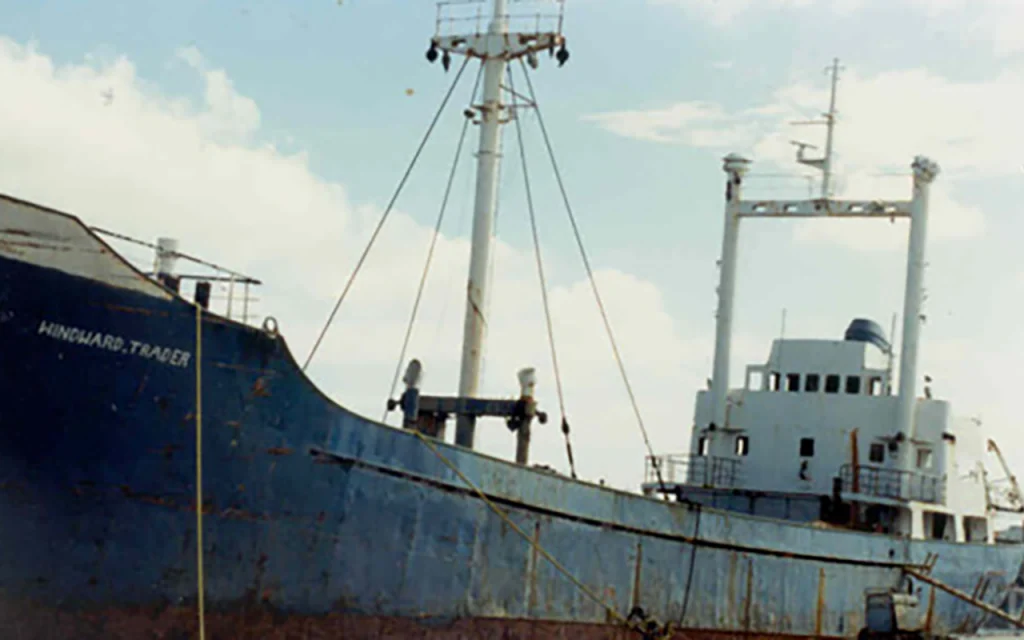
What Historical Features Can Still Be Identified on The Rodeo 25 Wreck
- Twin masts: The wreck’s most distinctive feature is its twin masts, which rise 68 feet above the wheelhouse. These masts create an impressive underwater structure and are often used by divers for silhouette photography.
- Wheelhouse: The wheelhouse structure is still identifiable on the wreck.
- Main deck: Although Hurricane Irma in 2017 caused further deterioration, parts of the main deck can still be observed, now resting in pieces at a depth of 113 feet.
- Hull structure: The overall 215-foot length and 33-foot beam of the Dutch freighter are still apparent, though the wreck now lists significantly to starboard.
- Bow section: The bow is reported to be almost on its side due to the effects of storms over the years.
- Stern superstructure: This part of the ship is mentioned as still being distinguishable, with the hull forward of it collapsing.
- Cargo holds: As a former cargo vessel, the ship’s hold areas may still be identifiable, though likely deteriorated.
- Propulsion system components: Remnants of the ship’s engine room or propulsion system might be visible, given its history as a cargo transport vessel.
It’s important to note that the wreck’s condition continues to evolve due to natural deterioration and the effects of storms. The invasive orange cup coral now colorfully decorates much of the structure, which may obscure some original features.Additionally, the wreck’s orientation has shifted over time, with it now listing to the starboard side and the bow almost completely on its side.
What Safety Measures Are in Place for Divers Visiting the Rodeo 25
- Diver Certification Requirements:
- The Rodeo 25 is classified as an advanced wreck dive.
- It’s recommended for advanced open water divers or open water divers under direct supervision of an instructor.
- Depth Considerations:
- The wreck sits at various depths, with the main deck at about 100 feet and a maximum depth of 125 feet.
- Divers must be trained and equipped for deep diving.
- Dive Planning:
- Proper dive planning is essential, including gas management for the depth.
- Many operators offer a two-dive plan to allow for adequate exploration of the wreck.
- Equipment Requirements:
- Divers should have appropriate gear for deep diving, including redundant air sources.
- For wreck penetration, proper training and equipment (like lights and guidelines) are mandatory.
- Dive Briefings:
- Dive operators typically provide detailed briefings on the wreck’s layout, potential hazards, and current conditions.
- Buddy System:
- Diving in pairs is standard practice for safety.
- Surface Support:
- Dive boats usually remain on-site during the dive to provide surface support.
- Emergency Preparedness:
- Dive operators should have emergency action plans in place.
- Oxygen and first aid equipment should be available on the boat.
- Weather and Sea Condition Monitoring:
- Dives are typically only conducted when conditions are favorable.
- Physical Fitness:
- Divers are advised to be in good physical condition and to honestly assess their fitness to dive.
- Wreck-Specific Considerations:
- Awareness of the wreck’s current condition, including its list to starboard and potential instabilities.
Dive Shops That Provide Diving Trips to This Shipwreck
- Force-E Scuba Centers – Pompano Beach
- Address: 1312 N Federal Hwy, Pompano Beach, FL 33062
- Phone: (954) 943-3483
- Website: https://www.force-e.com/dive-shops/pompano-beach/
- South Florida Diving Headquarters
- Address: 101 N Riverside Dr # 111, Pompano Beach, FL 33062
- Phone: (954) 783-2299
- Website: http://www.southfloridadiving.com/
- DH Scuba
- Address: 840 SE 22nd Ave, Pompano Beach, FL 33062
- Phone: (954) 294-5600
- Website: https://www.dhscuba.com/
Central Florida Wrecks
- SS Breconshire
- Georges Valentine
- Hog Heaven
- Urca De Lima
- USS Rankin
- Ana Cecilia
- United Caribbean
- USS Mindanao
- The Laertes
- Berry Patch Tug Wreck
- The Liberty Ship
- The Ana Cecilia
- The Cities Service Empire
- USS Accokeek
- The Tortuga Wreck
- Princess Ann Wreck (Palm Beach)
- Okinawa Wreck (Pompano Beach)
- MG-111 Wreck (Jupiter)
- Lady Luck Wreck (Pompano Beach)
- Rodeo 25 Wreck (Pompano Beach)
- Lowrance Wreck (Pompano Beach)
- RSB-1 Wreck (Deerfield Beach)
- Rebel Wreck (Deerfield Beach)
- Noulla Express Wreck (Fort Lauderdale)
- Sucre Wreck (Fort Lauderdale)
- Captain Tony Wreck (Pompano Beach)
- Peter McAllister Wreck (Pompano Beach)
- Guy Harvey Wreck (Fort Lauderdale)
- Quallman Tugs Wreck (Pompano Beach)
- Miller Lite Wreck (Pompano Beach)

